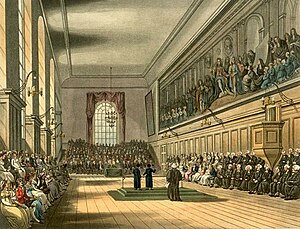Charity school


A charity school, also called Blue Coat School, was significant in the history of education in England. It was erected and maintained in various parishes by the voluntary contributions of the inhabitants for teaching poor children to read, write, and other necessary parts of education. It was usually maintained by religious organizations, which provided clothing and education to students freely or at little charge. In most charity schools, children were likewise put out to trades, services, etc., on the same charitable foundation. Some schools were more ambitious than this and sent a few pupils on to university, as depicted in the illustration.
Charity schools began in London, and spread throughout most of the urban areas in England and Wales. By 1710, the account of the charity schools in and around London stood thus: number of schools, 88; boys taught, 2181; girls, 1221; boys put out to apprentices, 967; girls, 407. By the 19th century, English elementary schools were predominantly charity schools.
Blue coat schools in order of foundation
- Christ's Hospital, Horsham, an independent boarding school founded in 1552. The first, greatest [dubious – discuss] and oldest surviving Bluecoat school.
- Blue Coat Boys' School, founded in 1574 and housed in the Poor Priest's Hospital in Canterbury, which later became Simon Langton Grammar School for Boys and Simon Langton Girl's Grammar School
- Queen Elizabeth's Hospital, Clifton, Bristol, also known as The City School, founded in 1586.
- Norwich School for Poor Boys, Norwich, also known as the Anguish School, founded by bequest in 1617 by Thomas Anguish, former mayor of the city.
- Reading Blue Coat School, a secondary school founded in 1646 by Richard Aldworth.
- Blue Coat School, Basingstoke - founded in 1646 by Richard Aldworth.
- Old Swinford Hospital, at Stourbridge founded in 1667.
- The King's Hospital or Blue Coat School, Dublin, an Irish school founded in 1669.
- Greenwich Blue Coat Girls' School, a girls' charity school founded in 1700.
- St Mary's School, Banbury, a primary school founded as Bluecoat School in 1705.
- York Bluecoat School, founded in 1705
- Nottingham Bluecoat School, a church school founded in 1706.
- Liverpool Blue Coat School, a grammar school founded in 1708.
- Nantwich Blue Cap School, founded before 1712.
- Tenison's School in Croydon, founded 1714.
- Coventry Blue Coat Church of England School, a comprehensive school founded in 1714.
- Stanhope School, founded 1715 before merging with the Addey School in 1894
- Birmingham Blue Coat School, an independent junior prep school founded in 1722.
- Bluecoat Primary School & Nursery, in Stamford, Lincolnshire, established in the 18th century.
- The Blue Coat School, Oldham, a school established in 1834.
- The Blue Coat School, Dudley, a school opened in 1869 and closed in 1989.
- Bishop of Hereford's Bluecoat School, a school founded in 1973.
- Pilton Bluecoat CofE Primary School, a junior school in Devon.
